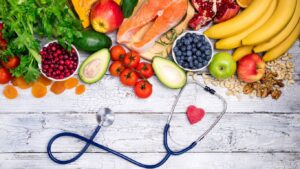Want to get healthy and save money? Read on below to find out how to get the most bang for your nutritional buck!
Being healthy doesn’t have to cost more. Many of us are on the lookout for budget-friendly, nourishing options- and there are plenty out there! Here are eight ways to help you and your family thrive nutritionally, all while making your money go further.
Let’s get cooking
Cooking at home is cheaper than eating out. Even if you don’t have a love of cooking, making your own fresh food is an important skill when you want to eat healthily and inexpensively.
If cooking is relatively new to you, or you’re not entirely comfortable with some parts of it, there are plenty of YouTube videos teaching basic skills like roasting a chicken, steaming vegies, whipping up a quick omelette or making a pot of soup or curry. You can also find many easy and delicious budget friendly meals, desserts and snacks at healthyfoodguide.com.au
MAKE YOUR OWN FOOD ‘CONVENIENT’
Pre-cut or pre-prepared foods may save time, but they always cost more. Packages like pre-made salads, cut-up fruit and even grated cheese can start to add up. With many people spending more time at home, these time-saving options may not be as necessary as they once seemed.
Plan your meals
Planning meals ‘on the fly’ while in store can be exhausting. Not planning means you come home from shopping with bags of goodies but nothing to make into a meal. And winging it when you get home after work can make you more likely to get frustrated and call or head out for takeaway.
Meal planning really is the best way to eat healthily and prevent waste- and it doesn’t need to be at all complicated. Most families have 5-6 go to favourite recipes, so start with what’s most familiar for you. Make it part of your plan to cook extra to take for lunch the next day.
MAKE A LIST & STICK TO IT
Without a list, you’re more likely to make impulse purchases in the supermarket, especially if you walk up and down random aisles. Plan your trip through the store according to your list- and don’t go shopping when you’re hungry, as there’s a greater chance you’ll grab extras you don’t even really want or need.
Perhaps consider ordering online, then either picking up the groceries in-store or getting them delivered. This can definitely help prevent impulse purchases.
USE UP WHAT YOU HAVE FIRST
Check the pantry and the fridge before you start planning to shop for meal ingredients. Can you make a meal with what you already have? Many people waste food because they buy more of what is already on their shelves or in the fridge. Doing a quick stocktake also gives you the chance to get creative- to try something new with what may be hiding in your cupboard.
RECONSIDER PROTEIN
Meat, chicken and fish are often the most expensive items in many people’s weekly shop. Diversify your protein by including much cheaper options like legumes- lentils, beans and chickpeas- that are packed with protein and will keep you feeling full.
You don’t have to become vegetarian, just halving your meat and bulking out your meals with legumes is a smart way to do this. Start by adding a can of lentils to your Bolognese and keep a range of canned legumes in your pantry, ready to add to salads, soups and to bulk out stews.
Tinned fish is cheaper than fresh, and eggs are another great inexpensive option to help boost protein in your meals.
Don’t buy just because of ‘specials’
Buying extra of your regular items when they’re on sale is a smart move, especially if they can be frozen or stored for a good while. However, buying something you spot on the end of an aisle that you wouldn’t normally buy- just because it’s half price- is not a bargain. Impulse buying items you or your family don’t normally eat is a waste of money, and can encourage you to overeat.
40% of household waste is made up of food. The best way to reduce wastage is to reduce the amount of food you throw out. Frozen veg can be a better option since they keep longer
Don’t fall for wellness fads
You may hear a lot about how you need coconut oil, matcha and the latest trendy- and expensive- supplement. However many food trends may only be loosely backed by science, if at all.
No one food is ever going to lengthen your life or make you healthy- it’s really the quality of your overall intake that matters. And none of these foods are a match for the nutrition you’ll get by eating plenty of fruit and veg.
If bought in season, they’ll be at their cheapest and most delicious. Fruit and veg provide the best nutritional bang for buck- and there are so many different, tasty ways to prepare them.
BEST BEFORE VS USE BY
A ‘best before’ date is really just a guide. As long as the packaging is not damaged and the food hasn’t been exposed to extreme heat, the food may still be safe to eat after that date. The worst that could happen is that the quality, flavour or texture is not quite as good. ‘Use by’ dates state when a product may no longer be safe to eat.
Reduce waste & save!
Q When do I need to ditch food?
Inspect food before throwing it out- if it’s not bad, use it up and save your money. But if you’re not sure, it’s best to trust your instincts. Use your eyes and nose. Look for visible signs of spoilage like mold, or for a funny smell. If it seems fine, it probably is, but if in doubt, chuck it out.
Q How do I maximise food shelf-life?
Freeze foods that are close to their use-by date and that you won’t use in time. Stew up fruit that’s going soft, freeze bananas that are turning brown (but peel them first), and make soups or stews from limp vegetables. If you have a humidity setting on your crisper, setting it to low will fruit that is prone to rotting easily- such as apples, pears and stone fruit- last a good while longer.
Q Should I reduce my portion sizes?
Buying, cooking and eating less is a sensible, positive way to reduce your shopping bill and waistline! Check out this handy online portion size guide to appropriate portions for different foods: healthyfoodguide.com.au/resources/portion-size-guide.




